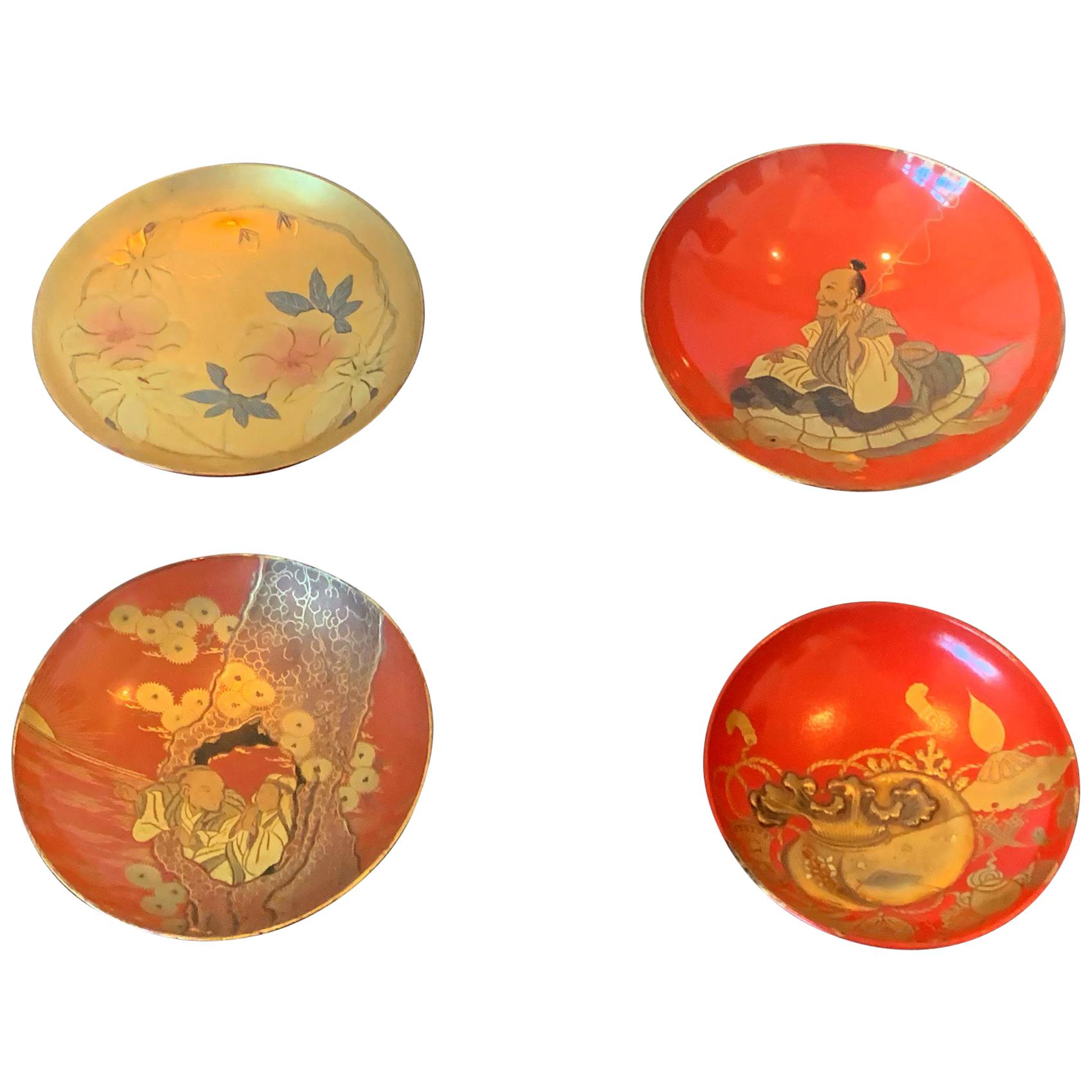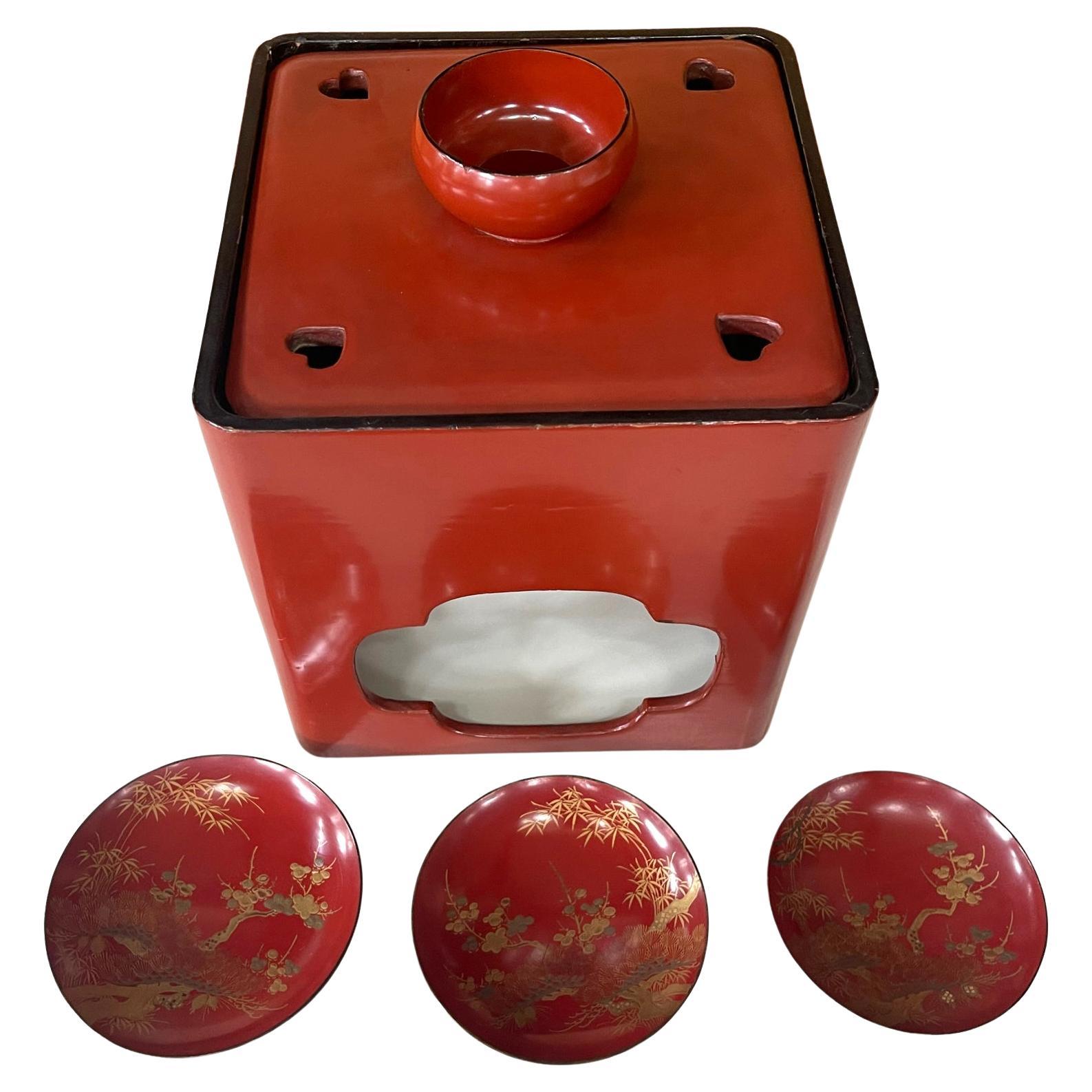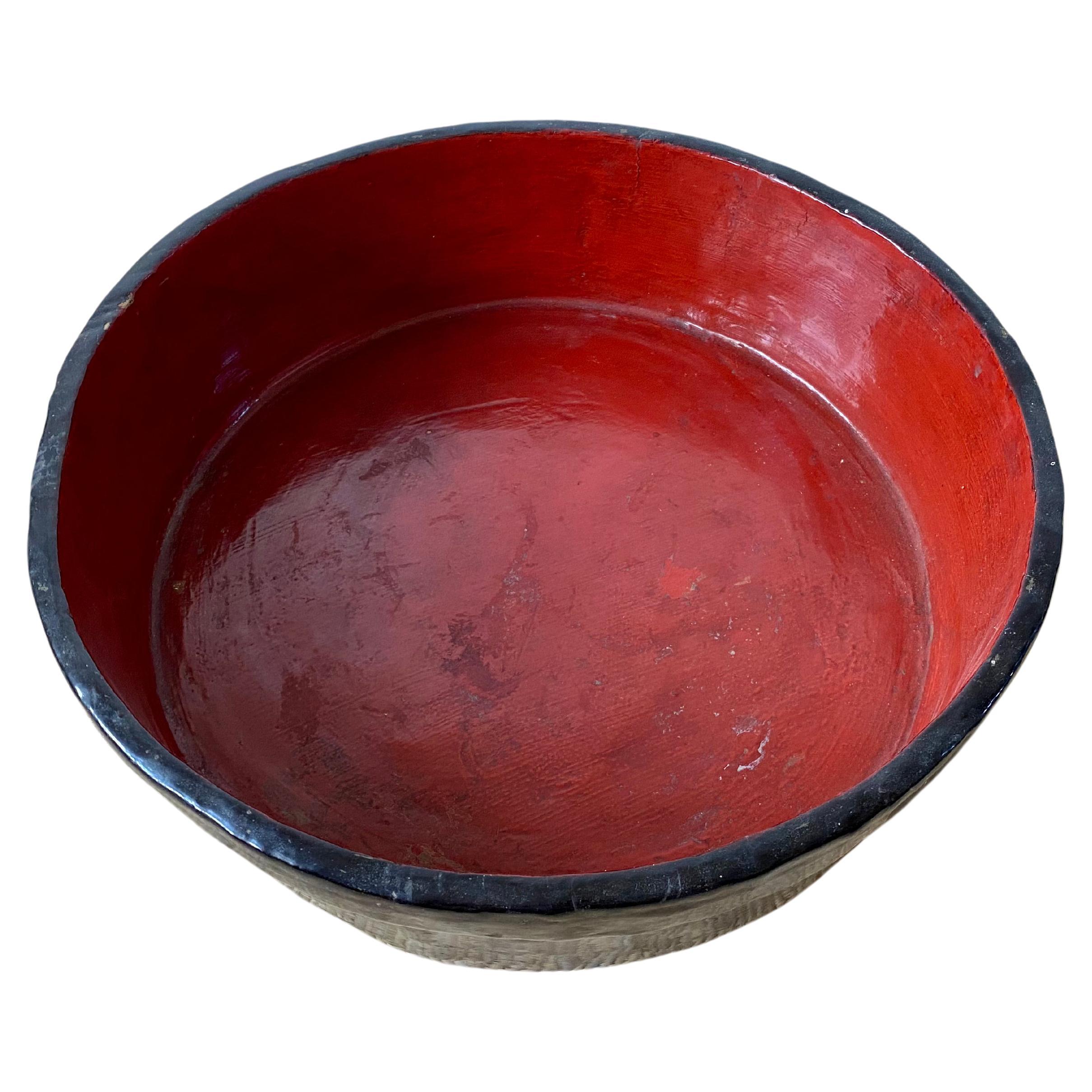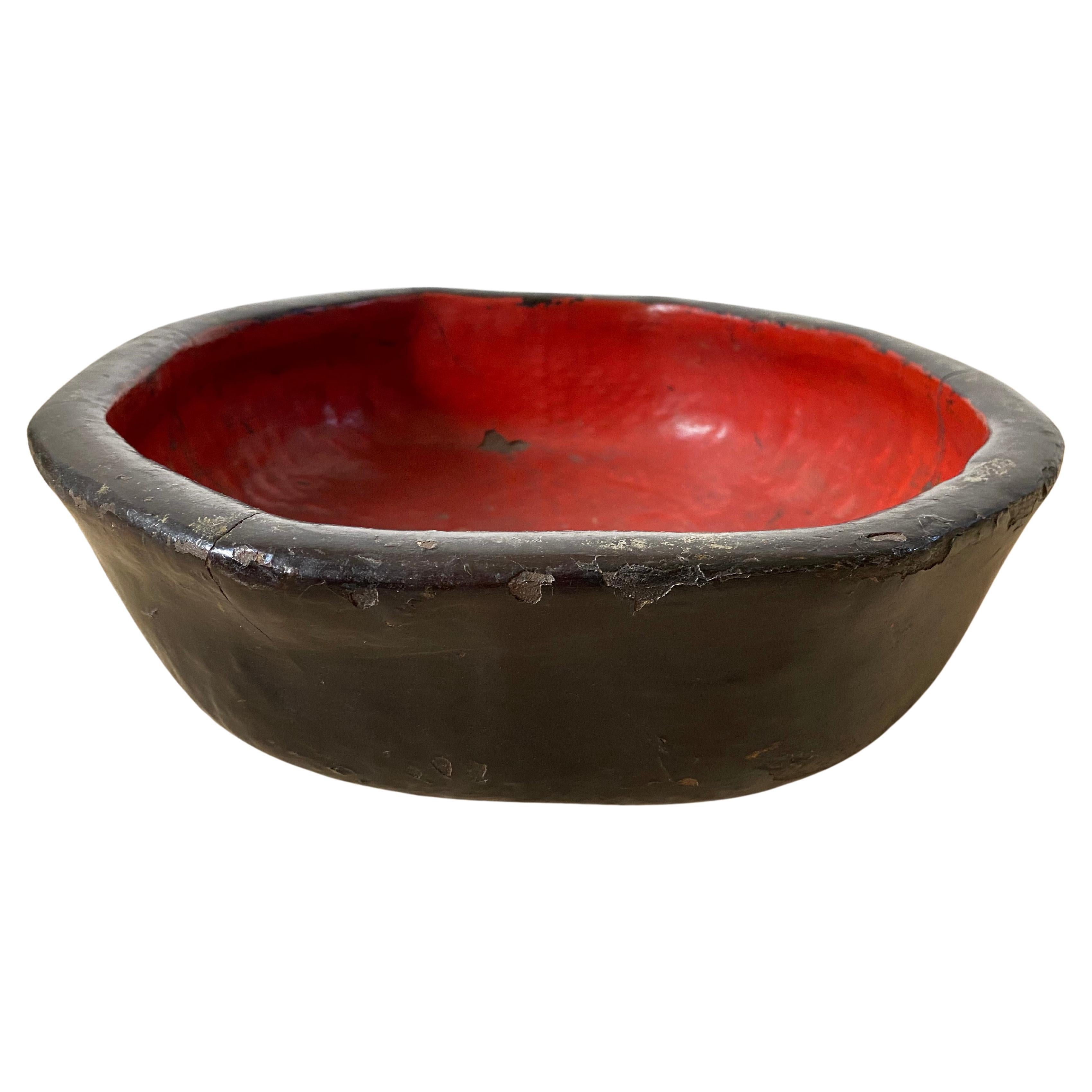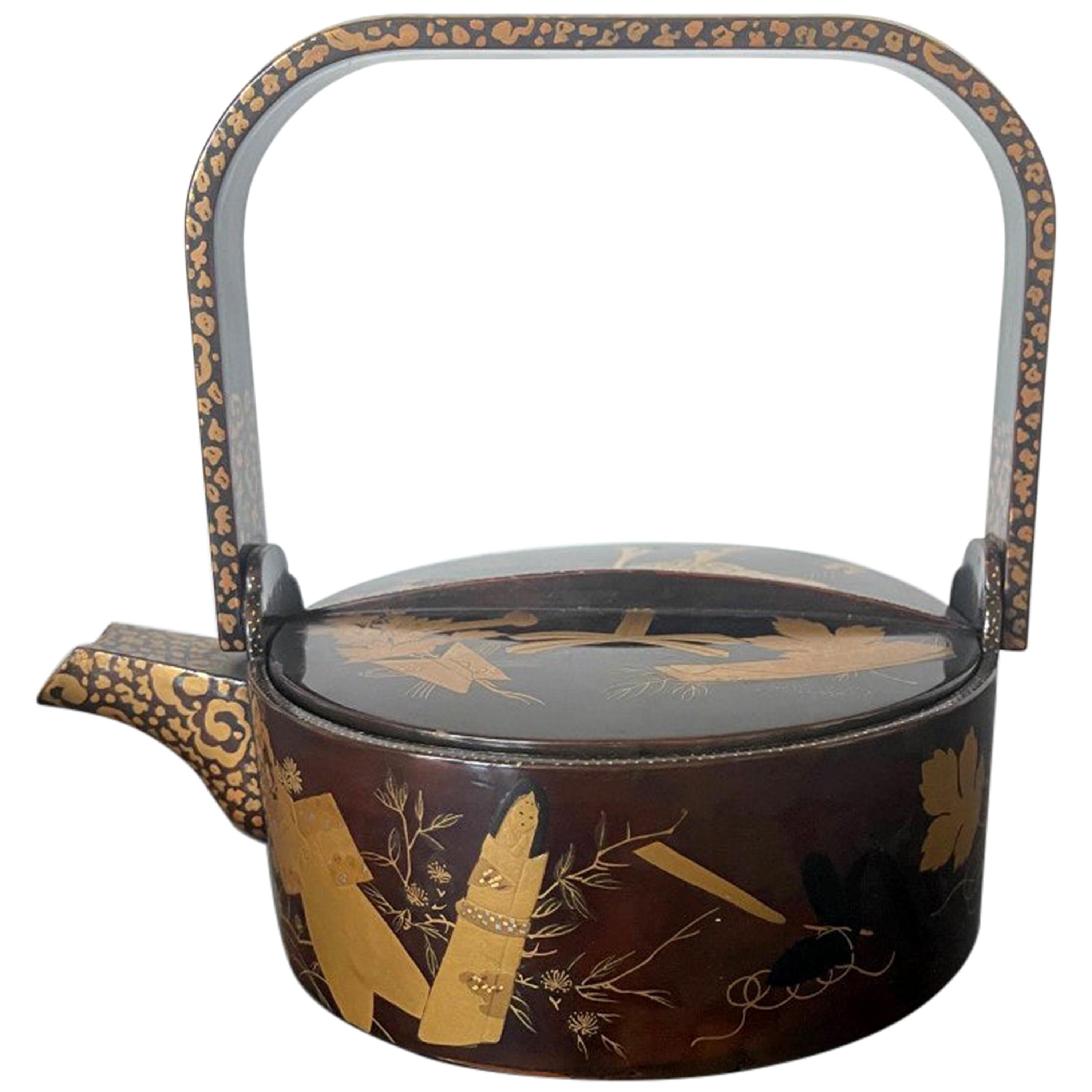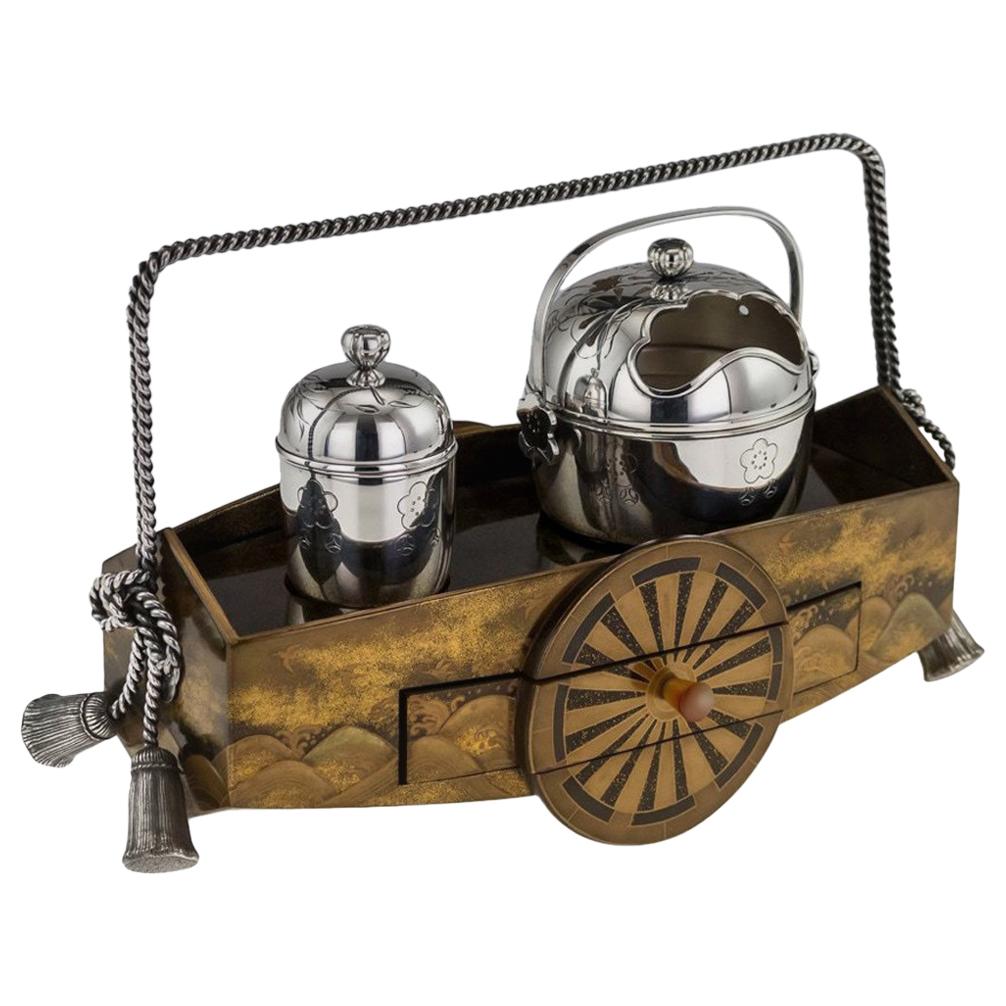Items Similar to Japanese Lacquer Sake Cups, Set of 3, Meiji Period, Early 20th Century, Japan
Want more images or videos?
Request additional images or videos from the seller
1 of 17
Japanese Lacquer Sake Cups, Set of 3, Meiji Period, Early 20th Century, Japan
About the Item
A finely decorated set of 3 red lacquer sake cups, sakazuki, featuring views of Mt. Fuji, Meiji period, circa 1900, Japan.
The lacquer sake cups, called sakazuki, of traditional pedestal bowl form, crafted as a shallow bowl supported by a high, slightly splayed, ring foot. The cups lacquered bright red, and decorated in the maki-e and takamaki-e techniques with three views of Mt. Fuji. The mouth and foot rims gilt.
Cup 1: The smallest cup features Mt. Fuji looming large, most of the mountain shrouded in a golden fog. A majestic dragon with inlaid crystal eyes makes his ascent towards the peak, clouds billowing around him.
The exterior of the bowl with images of eggplants and a hawk in flight. The combination of Mt. Fuji, a hawk, and an eggplant is known as Ichi Fuji, Ni Taka, San Nasubi (literally first Mt. Fuji, second the hawk, third an eggplant). It is said that if these elements appear in your dreams, especially the first dream of the new year, it is especially auspicious.
Measures: 5.63" x 1.88"
Cup 2: The midsize cup with a bold and dramatic scene of powerful crashing waves with plovers, chidori, flying above and between the sprays. Chidori and waves is a popular motif in Japanese art. The small birds flying fearlessly between large and rough waves symbolize strength and perseverance, while the sound the plovers make, "chiyo", sounds like the phrase "1000 Generations", interpreted as wishes for longevity. Mt. Fuji rises in the background.
The exterior of the cup with a wave design.
Measures: 6.88" x 2.25"
Cup 3: The largest of the sake cups features a tall and magnificent temple or pagoda spire, called a sorin, in the foreground. The sorin topped by a flaming jewel. Red-crowned cranes, a symbol of longevity and good fortune, descend from the sky. In the middle ground, are blossoming cherry branches. Mt. Fuji rises mysteriously in the background.
The exterior of the cup with branches of flowering cherry.
Measures: 7.5" x 2".
- Dimensions:Height: 2.5 in (6.35 cm)Diameter: 7.5 in (19.05 cm)
- Sold As:Set of 3
- Style:Meiji (Of the Period)
- Materials and Techniques:
- Place of Origin:
- Period:1900-1909
- Date of Manufacture:circa 1900
- Condition:Wear consistent with age and use. Minor losses. Minor fading. Minor losses to the metal inlay of the cherry blossoms in cup 1 and the water droplets in cup 2. Please see photos.
- Seller Location:Austin, TX
- Reference Number:1stDibs: LU894727611462
About the Seller
5.0
Platinum Seller
These expertly vetted sellers are 1stDibs' most experienced sellers and are rated highest by our customers.
Established in 2001
1stDibs seller since 2010
306 sales on 1stDibs
Typical response time: 1 hour
- ShippingRetrieving quote...Ships From: Austin, TX
- Return PolicyA return for this item may be initiated within 7 days of delivery.
More From This SellerView All
- Japanese Lacquer Display Cabinet on Stand, Meiji Period, 19th Century, JapanLocated in Austin, TXA spectacular Japanese lacquer and porcelain inlaid display cabinet on stand, kazaridana, Meiji Period, late 19th century, Japan. The sumptuous kazaridana of traditional display cabinet form, with several shelves and enclosed spaces for display and storage. The cabinet decorated all over in beautiful maki-e lacquer against a dense nashiji ground and inset with blue and white Arita porcelain plaques. The front of the cabinet of asymmetric design, with two open display shelves at staggered heights, and several doors enclosing storage areas of various shapes and sizes, including one hinged corner door, two pairs of sliding doors, and one pair of hinged doors opening to reveal a rounded inset corner shelf. A pair of drawers below complete the cabinet. All supported on a separate tall fitted stand. The corner door decorated with a bold scene of a samurai warrior fighting a demon. This most likely depicts the warrior Watanabe no Tsuna battling the demon Ibaraki-doji at Rashomon gate, in which Watanabe no Tsuna attempts to help a young girl return home, carrying her on his back, only for the girl to turn into a demon, which he then must fight. The top pair of sliding doors with a scene of a man playing the sho, a Japanese mouth organ, along the banks of a river with a waterfall in the background. The bottom pair of sliding doors with a waterfall scene on one side, while a scholar lounges with his attendants on the other. The pair of hinged doors finely decorated with a pair of fully armored samurai. The two drawers wonderfully decorated in the kodaiji style with a stream of rushing water and various plants and grasses. The cabinet is decorated in the round, with the top, sides, and base of the cabinet decorated with various scenes of flowers and birds, and inset with blue and white Arita porcelain plaques in the form of traditional fan. The fans painted...Category
Antique 1880s Japanese Meiji Lacquer
MaterialsPorcelain, Softwood, Lacquer
- Japanese Carved Cinnabar Lacquer Inro, Meiji Period, late 19th c, JapanLocated in Austin, TXA good Japanese carved cinnabar three case inro with mixed metal ojime, Meiji period, late 19th century, Japan. The three case inro of standard form, comprised of three container se...Category
Antique Late 19th Century Japanese Meiji Lacquer
MaterialsSilver, Copper
- Japanese Maki-e Lacquer Stacking Box, Jubako, Meiji Period, JapanLocated in Austin, TXA fine and impressive Japanese gold maki-e decorated black lacquer five-tier jubako with presentation tray, two lids, and the original tomobako storage box, Meiji period, late 19th c...Category
Antique Late 19th Century Japanese Meiji Lacquer
MaterialsLacquer
- Japanese Lacquer House Shaped Incense Box, Kogo, Meiji Period, JapanLocated in Austin, TXA delightful and intricately decorated lacquer box for storing incense, kogo, in the form of a traditional farm house, Meiji period (1864 - 1912), late 19th century, Japan. The kogo, or small box for storing incense, takes the whimsical form of a traditional Japanese home, minka, with the removable high, thatched roof serving as the cover for the box. The exterior of the home has been painstakingly decorated in maki-e lacquer against a matte black lacquer ground. Traditional shoji doors, bamboo blinds...Category
Antique Late 19th Century Japanese Meiji Lacquer
MaterialsLacquer
- Large Japanese Lacquer Document Box, Ryoshibako, Edo/Meiji period, JapanLocated in Austin, TXA large and magnificently decorated Japanese lacquer document box, ryoshibako, signed Umeboshi/Baikyo, late Edo or early Meiji Period, mid 19th century, Japan. The large document box, ryoshibako, of tall, rectangular shape with rounded corners, and fitted with an inrobuta (flush-fitting) cover with beveled edges. The exterior of this exquisite box is decorated all over with fifteen different raised reserves shaped as uchiwa (paddle) fans against a lush and intricate krikane ground imitating shagreen. The uchiwa shaped reserves all of takamaki-e, and exquisitely painted with designs of animals, flowers, and landscapes in silver, gold, maki-e, hiramaki-e, and takamaki-e, with kirikane, nashiji, and polychrome embellishments, upon gold lacquer fudame grounds. The interior of the lid is nothing short of spectacular, featuring a large design of a magnificent and beautifully detailed rooster and hen with chicks gathered around a lazy stream. Large stalks of chrysanthemum bloom behind them. All against an ethereal nashiji ground. The cover of the box features five reserves: 1. Three minogame (turtles with long tails), symbolizing longevity 2. "Narihira Crossing the Sumida" from The Tales of Ise...Category
Antique 1860s Japanese Meiji Lacquer
MaterialsSoftwood, Lacquer
- Small Japanese Lacquer Duck Incense Box, Kogo, Meiji Period, Late 19th CenturyLocated in Austin, TXAn exquisite Japanese Meiji Period small lacquer incense box, kogo, in the form of a duck or goose, late 19th century, Japan. The delicate lacquer box, known as a kogo in Japanese, ...Category
Antique Late 19th Century Japanese Meiji Lacquer
MaterialsLacquer
You May Also Like
- Four Japanese Lacquered Sake Cups Meiji PeriodLocated in Atlanta, GAAn assemble of four lacquerware sake cups from Meiji period Japan circa late 19th century. The shadow cups on an elevated stem were used by the nobles during ...Category
Antique Late 19th Century Japanese Meiji Lacquer
MaterialsWood, Lacquer
- Japanese Lacquered Sake Drinking Set Meiji PeriodLocated in Atlanta, GAA Japanese lacquered Sake Drinking set circa late 19th century (end of Meiji period), The assemble consists of a red lacquer stand open frame support and a lid that encloses a storage space with black lacquered interior. The lid features a and a cup holder in the center and four heart shape cutouts on the corners. There are three maki-e decorated sake cups with gradual sizes. The cups showcase on the red background elaborate gold hiramaki-e paintings...Category
Antique Late 19th Century Japanese Meiji Lacquer
MaterialsWood, Lacquer
- Large Japanese Red & Black Lacquer Wooden Bowl, Early 20th CenturyLocated in Jimbaran, BaliA Japanese red & black lacquer wooden bowl from the early 20th century. It is carved from a block of what is likely to be fruit wood. The bowl has aged beautifully over the years wit...Category
Early 20th Century Japanese Meiji Decorative Bowls
MaterialsFruitwood, Lacquer
- Japanese Red & Black Lacquer Bowl, Early 20th CenturyLocated in Jimbaran, BaliA Japanese red & black lacquer bowl from the early 20th century. Its frame is crafted from woven rattan fibres and covered in multiple layers of lac...Category
Early 20th Century Japanese Other Decorative Bowls
MaterialsRattan, Lacquer
- Japanese Lacquer Maki-e Sake Ewer Meiji PeriodLocated in Atlanta, GAA Japanese lacquered wood sake ewer with maki-e design, circa late 19th century, Meiji period. The nicely decorated lacquerware is of a Classic sake ewer for...Category
Antique 1890s Japanese Japonisme Lacquer
MaterialsLacquer
- 20th Century Japanese Meiji Period Silver & Gold Lacquer Smoking Set, circa 1900Located in Royal Tunbridge Wells, KentAntique early 20th century Japanese Meiji period very fine gold lacquer and silver smoking set (tabako-bon), boat shaped with a removable draw, lacquer is decorated with ocean waves ...Category
Early 20th Century Japanese Lacquer
MaterialsSilver
Recently Viewed
View AllMore Ways To Browse
New Lacquered Furniture
20th Century Cup
Traditional Japanese Furniture
Cup Set
Japanese Motif
Tall Lacquered
Early 20th Century Jewels
Japanese Motif Furniture
Japanese Symbol
Antique Jewel Set
Antique Japanese Set
Pagoda Red
Red Pagoda
Pagoda Red Furniture
Japanese Blossom
Antique Cup Set
Japanese Golden
Inlaid Lacquer
